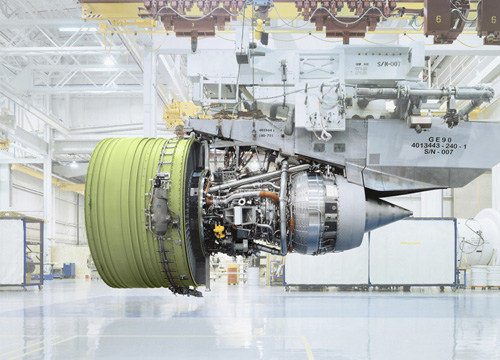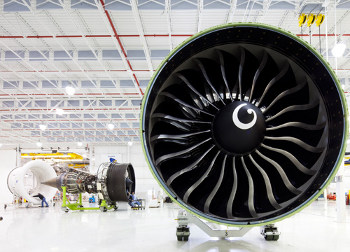 |
| October 08, 2013 | Volume 09 Issue 38 |
Designfax weekly eMagazine
Archives
Partners
Manufacturing Center
Product Spotlight
Modern Applications News
Metalworking Ideas For
Today's Job Shops
Tooling and Production
Strategies for large
metalworking plants
Wheels (and wings):
World's largest jet engine gets bigger -- and better
By GE Reports
The GE90 is already the largest and most powerful jet engine ever built. But that doesn't mean that GE engineers have stopped trying to make it bigger, better, and leaner.

GE's GE90 is the largest and most powerful jet engine ever built. [Photo: GE]
Its new version, called GE9X, will power Boeing's next-generation 777X aircraft. This fall, GE plans to take new high-strength carbon fiber composite blades developed for the GE9X for a spin at Boeing's testing rig in Seattle. The new blades and other parts from breakthrough materials will reduce the GE9X's fuel use and environmental impact. Bill Millhaem, general manager of GE Aviation's GE90 program, says that the new engine will deliver more than 10 percent fuel efficiency improvement compared to the GE90-115B engine, which belongs to GE's ecomagination portfolio.
At 132 in. in diameter, the GE9X front fan will be even larger than the one used by its older sibling. Fourth-generation composites allowed the blades to be fewer and thinner, with the same strength and durability. The GE9X has only 16 fan blades, down from 22 on the GE90-115B engine and 18 on the GEnx. These improvements will drive up fuel efficiency and shed hundreds of pounds of weight from the blades and the structures needed to support them.
The new blades will also enable engineers to increase fan tip speed, improve efficiency of the low-pressure turbine, and contribute to the engine's fuel-burn improvement.
The GE9X's durable, lightweight fan case, similar to that used on the Genx, will also be made from composites. Compared to a metal fan case, the composite unit will lower the engine's weight by 350 lb.

GE's GE90. [Photo: GE]
Other high-tech materials inside the GE9X engine include ceramic matrix composites (CMCs) that can perform at temperatures as high as 2,400 deg F -- hotter conditions than any alloy can handle. Engineers say the engine will burn less fuel than the GE90-115B, in part due to CMC parts in the combustor and turbine.
GE Aviation developed the first composite fan blade for its GE90-94B engine in 1995. Such blades are also featured in the GE90-115B and GEnx engines.
GE Aviation has been conducting tests on new materials and technologies for the engine over the last few years. Along with fan-blade tests at the ITP engine-testing facility in the United Kingdom, GE Aviation began assessing a high-pressure compressor rig at a GE Oil & Gas facility in Massa, Italy, in August.
The first GE9X engine will be tested in 2016, with trials on GE's flying test bed anticipated in 2017. Engine certification is scheduled for 2018.
Fun fact: The GE90-115B engine, used exclusively in Boeing's 777-300ER, 777-200LR, and 777 freighters, generated 127,900 lb thrust at a GE test stand in Peebles, Ohio, in 2002. The feat earned the engine a spot in the Guinness World Records book. Compare that to the Redstone rocket (76,000 lb thrust) that took the first American astronaut, Alan Shepard, to space.
More than 1,500 GE90-115B engines have been ordered by customers for their Boeing 777s.
Read more GE news at gereports.com.
Published October 2013
Rate this article
View our terms of use and privacy policy
